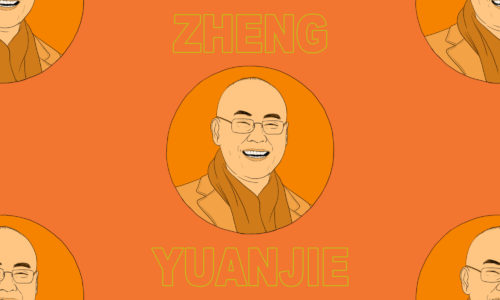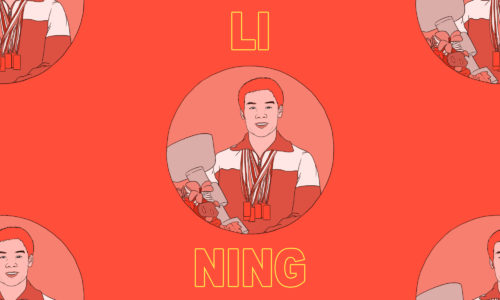Depending on who you ask, automobiles, bicycles, and flying machines found their first forms in the mountainous terrain of Gansu over 2,000 years ago. Their creator is a mysterious figure who has snowballed into legend, his name put to the invention of all sorts of labor-saving tools, a personification of the nameless hundreds of innovative craftsmen who made sophisticated Chinese crafts possible. He’s the god of builders and contractors in Chinese folk religion, Lǔ Bān 鲁班.
Even today the phrase 班门弄斧 bān mén nòng fǔ — literally, “to brandish your axe at Lu Ban’s door” — is a common idiom, used to describe people who unwittingly boast their small achievements in front of those who’ve set the bar, like showing off one’s front-crawl to Michael Phelps or boasting about your lead role in an am-dram in front of Tom Hanks.
Who is Lu Ban?
Rather like wonder-surgeon Huà Tuó 华佗, Lu Ban’s legend thrived on the weight of generations of acceptance — existing evidence trumped by past precedent and the dazzling narrative of ancient China’s sophisticated lore.
Lu Ban’s a vague appellation, just meaning “Ban from the State of Lu.” The root of this character may have been a real person called Gōngshū Pán 公输盘 (or is it Gong Shuzi?), who lived during the twilight years of the Zhou Dynasty, when Lu and other states had fractured into the wars of the Spring and Autumn Period (770 — 481 BC). Born to a family of carpenters, perhaps in Dunhuang, it’s possible he was either a freed slave or wandering artisan.
Legend says he was a mediocre school boy who disliked reading and writing. But he was inspired by studying under Confucius’s disciple Zixia, then apprenticed to the sage carpenter Bao Laodong.
He began working in the service of the expansionist State of Chu, one of the most powerful states of the Spring and Autumn Period. He built weapons of siege and naval warfare, like the so-called “cloud ladder” — a siege engine that allowed attackers to rain down arrows and fire on the besieged from makeshift higher ground. He created grappling hooks and rams for naval warfare, standardizing the length of Chu weapons. The Book of “Mozi” says this led the Chu to victory in wars over their enemies.
But it’s his inventions that helped the people for which he’s best remembered. Wood was the staple building material in ancient China. As a result, the dominant building tools were portable and light — not the sledgehammers and cranes of the quarry, but the chisel (凿 záo), shovel (铲 chǎn), planer (刨 báo), and bow drill (钻 zuān), all inventions assigned to Lu Ban. The philosopher Mencius credited him for the first carpenter’s square (曲尺 qūchǐ); Lu Ban even lends his name to a line of folding stools used by laborers.
Most famous is his invention of the frame saw (锯 jù). Ordered by King Yuan of Zhou to build a palace, he was warned he and his team would suffer a brutal punishment (possibly beheading) for missing the deadline. Axes were the only way to gather and prepare the timber. It was too slow. Concerned, Lu Ban hurried up a very steep hill to the building site. Hauling himself up by grabbing plants, he cut his hand on the serrated edge of one of the grasses he was holding. This became inspiration for the teeth that make a saw cut through wood quickly and cleanly.
But others helped him too. According to legend, Lu Ban’s wife, concerned at seeing her husband toiling away at his work in soaking rain and scorching sun, designed a portable pavilion to give him shelter wherever he went. Today we know it as the umbrella.
Although Joseph Needham said there was no reason to doubt he did exist, there’s no archaeological evidence to suggest it, merely a set of books dating from the 3rd-century BC to the 13th-century AD. Yet there are consistent mentions of him designing a bamboo “bird” (perhaps a form of kite) that could stay in the air for up to three days, and a mechanical “wooden horse carriage” capable of self-propulsion. He made the latter to help his frail old mother — but according to the Lu Heng (a Han Dynasty text), “When his mother rode on it, it sped away never to return.” But there are no surviving models or images to definitively prove the existence of either of these.
Crafting a legacy
Lu Ban gained followers both high and low. Government officials offered gifts to him before starting a big construction project, while carpenters and builders would kowtow to him before raising the central roof beam of a new building. Daoists suggested he’d only invented his tools to make sure man harmonized with the perfect designs of the universe.
Unlike scholars or physicians, inventors and architects were merely humble artisans. Although treated as a saint by all, his core followers were lowly. The Lu Ban Jing, a handbook, claimed to divulge his secrets to craftsmen — not just how best to build a pagoda, wheelbarrow, or granary, but also how to ward off evil spirits, the correct day and hour to fell trees, and lists of evil stars to be avoided. A century ago, carpenters in Sichuan would wash, burn incense, and make sacrifices to “the immortal master Lu Ban, Lord of the Earth, the second of the Three Worlds” before they even opened the book.
They had reason to be grateful. According to archeological research, the frame saw didn’t appear in China until 500 AD, the earliest use of a planer dating only to the 14th century. Hours of backbreaking labor with less specialized tools could have loomed large in the collective memory, crafting a narrative of thanks around a single person.
According to the Chinese Communist Party, Lu Ban’s motivations were to help the common people (much like the narrative they sculpted for the apothecarist Lǐ Shízhēn 李时珍). A man who designed the first stone mill (石磨 shímò) for grinding flour (just because he felt bad for an old woman struggling to bash wheat with pestle and mortar) could only be dedicated to easing their hard burden. Magical legends recorded in the Lu Ban Jing — his using a wooden statue to curse a rival Kingdom which had killed his father — have faded from his legend.
In this narrative he’s a classic peasant scholar who shunned book-based learning, demonstrating the value of the earthy knowledge that comes from generations of trial-and-error. Images showed him as big and brawny, evidence of his years of hard labor. A 1958 film celebrated his life, “the incarnation of the industrious wisdom of the working people” according to Douban, which “proves that extraordinary miracles are created from ordinary labor.”
Lu Ban inevitably holds less authority than he used to. Traditional crafts are slowly dying; prefab tower blocks in a mayfly cycle of build-demolish-rebuild constitutes the majority of home-building; handicrafts shunted aside by the plastics of factories in Zhejiang and Shenzhen.
But you can still find the Lu Ban ruler amongst Feng Shui enthusiasts: rather like the tape measure from Mary Poppins, different measurements are assigned characteristics. Windows, doors, or furniture of dimensions around 17 cm would ensure the homeowner has an abundance of descendants, but ones closer to 9 cm puts the resident at risk for a spell in jail.
For some, Lu Ban’s inventions are valuable proof of Chinese talent. Not for nothing have Chinese inventors tried to prove the existence of his wooden horse carriage and flying machine by research-based reconstructions. One Beijinger claimed to have rebuilt Lu Ban’s proto-bicycle, which he tested on the streets of Beijing back in 2010. “It is quite slow and looks like very hard work to steer and control,” as one bystander dryly put it.
But the state looks beyond historical accuracy, to the sophisticated cultural tradition he stood for. It’s for this reason that CCP politicians have given complex “Lu Ban lock” toy puzzles as gifts to foreign dignitaries. The videos of “Grandpa Amu” — a traditional carpenter and hit YouTube vlogger churning out tables, bridges, even walking Peppa Pig machines — earned him the title of “contemporary Lu Ban” in state media. Whether the man existed or not is irrelevant; he’s a symbol of Chinese excellence.
Chinese Lives is a weekly series.






